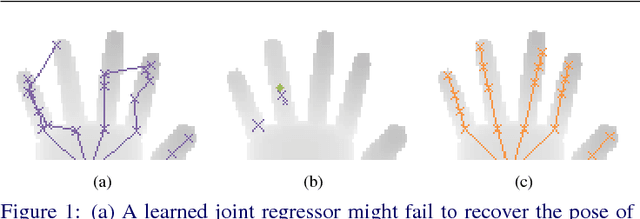Damien Michel
Hybrid One-Shot 3D Hand Pose Estimation by Exploiting Uncertainties
Oct 27, 2015

Abstract:Model-based approaches to 3D hand tracking have been shown to perform well in a wide range of scenarios. However, they require initialisation and cannot recover easily from tracking failures that occur due to fast hand motions. Data-driven approaches, on the other hand, can quickly deliver a solution, but the results often suffer from lower accuracy or missing anatomical validity compared to those obtained from model-based approaches. In this work we propose a hybrid approach for hand pose estimation from a single depth image. First, a learned regressor is employed to deliver multiple initial hypotheses for the 3D position of each hand joint. Subsequently, the kinematic parameters of a 3D hand model are found by deliberately exploiting the inherent uncertainty of the inferred joint proposals. This way, the method provides anatomically valid and accurate solutions without requiring manual initialisation or suffering from track losses. Quantitative results on several standard datasets demonstrate that the proposed method outperforms state-of-the-art representatives of the model-based, data-driven and hybrid paradigms.
 Add to Chrome
Add to Chrome Add to Firefox
Add to Firefox Add to Edge
Add to Edge